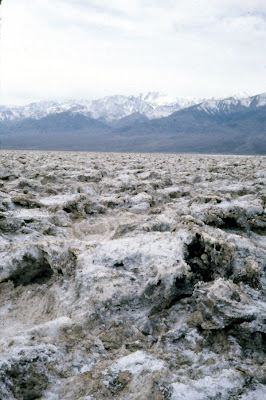 |
Death Valley is one of the hottest, driest places in California.
One would not expect to find much life here. Photo by F. C. Essig,
father of the author. |
I continue my recollections of wildflower hunting in California with a trip to the desert. We think of deserts as desolate, bone-dry, oven-hot places, where camels trek across endless sand dunes in search of oases surrounded by date palms. California deserts are exactly like that, except that the native palms don't provide edible dates, there are more dry mountain ranges and rocky flats than sand dunes, the winters are colder, winter rain storms are more frequent, and there are only a few pet camels.
 |
In the rain shadow of the Sierra Nevada,
the floor of Death Valley is also the lowest
spot (282 feet (86.0 m) below sea level.
Because there is no drainage, salt accumulates
and crystallizes in dry lake beds, such as
the "Devil's Golf Course," pictured here.
Photo by F. C. Essig |
 |
| Along the saline waterways in Death Valley, salt-tolerant pickleweed (Allenrolfea occidentalis) and grasses fluorish. Photo by F. C. Essig |
 |
Even in Death Valley, wildflowers can appear after rain. This
Indian Paint Brush (Castilleja applegatei) grows on the hillsides above
the saline plain. (photo by F. C. Essig) |
What people really don't expect in the desert are lush wildflower beds. The winter rains that bring poppies and lupines to California hillsides occasionally make it over the mountains to the Colorado and Mohave deserts, bringing to life dormant bulbs, rootstocks, and seeds, resulting in some of the most spectacular displays in the state. One of the best places to see desert wildflowers in all their glory is Anza-Borrego State Park. This is in the Colorado (or Sonoran) Desert, where the winters are somewhat warmer and rainier than in the Mohave Desert to the north.
 |
The native fan palm of California (Washingtonia filifera) occurs in the canyon oases
of the California desert. Photo by F. C. Essig |
 |
Bert Hunt and some students examine lupines blooming
beside the road. |
 |
| Dr. Jaeger relaxes during a Palaver. |
The desert was nearby when I was growing up in Riverside, California, and I was fortunate to have a dedicated teacher named Bert Hunt, who was avidly interested in everything, and would take groups of us to the deserts and mountains on field trips. When I went to college at UC Riverside, I had the opportunity to learn more about the desert's secrets from plant taxonomy professor Frank Vasek and herbarium curator at that time, Oscar Clarke. On several occasions, I also attended the famous "palavers" led by Dr. Edmund Jaeger. These massive field trips/campouts in the desert were traditionally for "men only," which drove many young female botanists to disguise their feminine assets and observe the goings-on from the periphery. It was an opportunity to learn from the "old man of the desert himself." One of Dr. Jaeger's notable achievements was to document hibernation in birds, specifically the desert poorwill, for the first time.
Below are just a few of my ancient photos of the wildflowers of Anza-Borrego. See much more at
http://www.abdnha.org/pages/03flora/family/index.htm
 |
Mimulus bigelovii, a desert monkey-flower,
blooms a few weeks after sprouting from a seed in
the Anza-Borrego State Park. |
 |
Monptilon bellioides, the desert star, is another
quick-blooming annual in the sunflower family in Anza-
Borrego. |
 |
The desert lily, Hesperocallis undulata, emerges from
a bulb after a rainstorm. |
 |
| A desert form of California Poppy. |
 |
Cacti, such as this Opuntia basilaris, are iconic members of
the desert flora, but only in the New World. Cacti are not
naturally found in the deserts of Africa, Asia, or Australia, but
have escaped as weeds in a some places. Cacti, and a few
hardy shrubs like Creosote Bush (Larrea divaricata) are
highly drought-resistant and remain green all year.
|





